Assessing the Distribution of Potentially Toxic Elements in Bryophytes in Relation to Surface Soil Contamination in the Veles Region, North Macedonia
Abstract
1. Introduction
2. Results and Discussion
3. Conclusions
4. Materials and Methods
4.1. Study Area
4.2. Geological Description
4.3. Moss and Soil Sampling, Preparation, and Analysis
4.4. Advantages and Limitations of Moss Biomonitoring
4.4.1. Advantages of Moss Biomonitoring
4.4.2. Limitations in Moss Biomonitoring
4.4.3. Comparison with Other Biomonitoring Methods
4.5. Data Processing and Statistical Analysis
5. Prospects
Supplementary Materials
Author Contributions
Funding
Institutional Review Board Statement
Data Availability Statement
Conflicts of Interest
References
- Berg, T.; Røyset, O.; Steinnes, E. Moss (Hylocomium splendens) used as biomonitor of atmospheric trace element deposition: Estimation of uptake efficiencies. Atmos. Environ. 1995, 29, 353–360. [Google Scholar] [CrossRef]
- Berg, T.; Steinnes, E. Use of mosses (Hylocomium splendens and Pleuroziumschreberi) as biomonitors of heavy metal deposition: From relative to absolute deposition values. Environ. Pollut. 1997, 98, 61–71. [Google Scholar] [CrossRef]
- Shaw, A.J.; Goffinet, B. Bryophyte Biology; Cambridge University Press: Cambridge, UK, 2000. [Google Scholar]
- Blagnyte, R.; Paliulis, D. Determination of heavy metals in moss (Pylaisia polanthia) along the high intensive traffic flow in Gelezinis vilkas street (Vilnius, Lithuania). In Proceedings of the 8th International Conference “Environmental Engineering”, Vilnius, Lithuania, 19–20 May 2011; Selected papers. pp. 31–36. [Google Scholar]
- Kłos, A.; Ziembik, Z.; Rajfur, M.; Dołhańczuk-Śródka, A.; Bochenek, Z.; Bjerke, J.W.; Tømmervik, H.; Zagajewski, B.; Ziółkowski, D.; Jerz, D.; et al. Using moss and lichens in biomonitoring of heavy-metal contamination of forest areas in southern and north-eastern Poland. Sci. Total Environ. 2018, 627, 438–449. [Google Scholar] [CrossRef] [PubMed]
- Lee, C.S.L.; Li, X.; Zhang, G.; Peng, X.; Zhang, L. Biomonitoring of trace metals in the atmosphere using moss (Hypnum plumaeforme) in the Nanling Mountains and the Pearl River Delta, Southern China. Atmos. Environ. 2005, 39, 397–407. [Google Scholar] [CrossRef]
- Mahapatra, B.; Dhal, N.K.; Dash, A.K.; Panda, B.P.; Panigrahi, K.C.S.; Pradhan, A. Perspective of mitigating atmospheric heavy metal pollution: Using mosses as biomonitoring and indicator organism. Environ. Sci. Pollut. Res. 2019, 26, 29620–29638. [Google Scholar] [CrossRef]
- Conti, M.E.; Tudino, M.B. Lichens as Biomonitors of Heavy-Metal Pollution. Compr. Anal. Chem. 2016, 73, 117–145. [Google Scholar]
- Kularatne, K.I.A.; De Freitas, C.R. Epiphytic lichens as biomonitors of airborne heavy metal pollution. Environ. Exp. Bot. 2013, 88, 24–32. [Google Scholar] [CrossRef]
- Alexandrino, K.; Viteri, F.; Rybarczyk, Y.; Guevara Andino, J.E.; Zalakeviciute, R. Biomonitoring of metal levels in urban areas with different vehicular traffic intensity by using Araucaria heterophylla needles. Ecol. Indic. 2020, 117, 106701. [Google Scholar] [CrossRef]
- Pakeman, R.J.; Hankard, P.K.; Osborn, D. Plants as biomonitors of atmospheric pollution: Their potential for use in pollution regulation. Rev. Environ. Contam. Toxicol. 1998, 157, 1–23. [Google Scholar]
- Vergel, K.; Zinicovscaia, I.; Yushin, N.; Frontasyeva, M.V. Heavy Metal Atmospheric Deposition Study in Moscow Region, Russia. Bull. Environ. Contam. Toxicol. 2019, 103, 435–440. [Google Scholar] [CrossRef]
- Stihi, C.; Popescu, I.V.; Frontasyeva, M.; Radulescu, C.; Ene, A.; Culicov, O.; Zinicovscaia, I.; Dulama, I.D.; Cucu-Man, S.; Todoran, R.; et al. Characterization of Heavy Metal Air Pollution in Romania Using Moss Biomonitoring, Neutron Activation Analysis, and Atomic Absorption Spectrometry. Anal. Lett. 2017, 50, 2851–2858. [Google Scholar] [CrossRef]
- Hristozova, G.; Marinova, S.; Svozilík, V.; Nekhoroshkov, P.; Frontasyeva, M.V. Biomonitoring of elemental atmospheric deposition: Spatial distributions in the 2015/2016 moss survey in Bulgaria. J. Radioanal. Nucl. Chem. 2020, 323, 839–849. [Google Scholar] [CrossRef]
- Zinicovscaia, I.; Hramco, C.; Duliu, O.G.; Vergel, K.; Culicov, O.A.; Frontasyeva, M.V.; Duca, G. Air Pollution Study in the Republic of Moldova Using Moss Biomonitoring Technique. Bull. Environ. Contam. Toxicol. 2017, 98, 262–269. [Google Scholar] [CrossRef] [PubMed]
- Stanković, J.D.; Sabovljević, A.D.; Sabovljević, M.S. Bryophytes and heavy metals: A review. Acta Bot. Croat. 2018, 77, 109–118. [Google Scholar] [CrossRef]
- Nordic Council of Ministers. Atmospheric Heavy Metal Deposition in Europe:–Estimation Based on Moss Analysis; Nordic Council of Ministers: Copenhagen, Denmark, 1994. [Google Scholar]
- Basile, A.; Sorbo, S.; Pisani, T.; Paoli, L.; Munzi, S.; Loppi, S. Bioacumulation and ultrastructural effects of Cd, Cu, Pb and Zn in the moss Scorpiurum circinatum (Brid.) Fleisch. & Loeske. Environ. Pollut. 2012, 166, 208–211. [Google Scholar] [CrossRef]
- Vazquez, M.D.; Lopez, J.; Carballeira, A. Uptake of heavy metals to the extracellular and intracellular compartments in three species of aquatic bryophyte Ecotoxicol. Environ. Saf. 1999, 44, 12–24. [Google Scholar] [CrossRef]
- Chorpa, R.N.; Kumra, P.K. Biology of Bryophytes; New Age International Pvt Ltd Publishers: New Delhi, India, 2005. [Google Scholar]
- Harmens, H.; Norris, D. Spatial and Temporal Trends in Heavy Metal Accumulation in Mosses in Europe (1990–2005); Harmens, H., Noris, D., Eds.; Programme Coordination Centre for the ICP Vegetation, Centre for Ecology & Hydrology, Natural Environment Research Council: Bangor, UK, 2008. [Google Scholar]
- Harmens, H.; Norris, D.; Mills, G. (Eds.) Heavy Metals and Nitrogen in Mosses: Spatial Patterns in 2010/2011 and Long-Term Temporal Trends in EUROPE; ICP Vegetation Programme Coordination Centre, Centre for Ecology and Hydrology: Bangor, UK, 2013; p. 63. [Google Scholar]
- Frontasyeva, M.; Harmens, H.; Uzhinskiy, A. Mosses as Biomonitors of Air Pollution: 2015/2016 Survey on Heavy Metals, Nitrogen and POPs in Europe and Beyond; LRTAP: Châtelaine, Switzerland, 2020; ISBN 9785953005081. [Google Scholar]
- Barandovski, L.; Cekova, M.; Frontasyeva, M.V.; Pavlov, S.S.; Stafilov, T.; Steinnes, E.; Urumov, V. Atmospheric deposition of trace element pollutants in Macedonia studied by the moss biomonitoring technique. Environ. Monit. Assess. 2008, 138, 107–118. [Google Scholar] [CrossRef]
- Barandovski, L.; Stafilov, T.; Šajn, R.; Frontasyeva, M.V.; Bačeva Andonovska, K. Atmospheric heavy metal deposition in North Macedonia from 2002 to 2010 studied by the moss biomonitoring technique. Atmosphere 2020, 11, 929. [Google Scholar] [CrossRef]
- Barandovski, L.; Stafilov, T.; Šajn, R.; Bačeva Andonovska, K.; Frontasyeva, M.; Zinicovscaia, I. Assessment of atmospheric deposition of potentially toxic elements in Macedonia using moss biomonitoring technique. Sustainability 2024, 16, 748. [Google Scholar] [CrossRef]
- Stafilov, T.; Šajn, R.; Barandovski, L.; Bačeva Andonovska, K.; Malinovska, S. Moss biomonitoring of atmospheric deposition study of minor and trace elements in Macedonia. Air Qual. Atmos. Health 2018, 11, 137–152. [Google Scholar] [CrossRef]
- Stafilov, T.; Šajn, R.; Pančevski, Z.; Boev, B.; Frontasyeva, M.V.; Strelkova, L.P. Heavy metal contamination of surface soils around a lead and zinc smelter in the Republic of Macedonia. J. Hazard. Mater. 2010, 175, 896–914. [Google Scholar] [CrossRef]
- Šajn, R.; Pančevski, Z.; Frontasyeva, M.; Stafilov, T. Levels and distribution of chemical elements in house dust from the area of an abandoned Pb-Zn smelter in North Macedonia. J. Environ. Sci. Health A 2023, 58, 1–12. [Google Scholar] [CrossRef] [PubMed]
- Stankovska, E.; Stafilov, T.; Šajn, R. Monitoring of trace elements in honey from the Republic Macedonia by atomic absorption spectrometry. Environ. Monit. Asses. 2008, 142, 117–126. [Google Scholar] [CrossRef]
- Pančevski, Z.; Stafilov, T.; Bačeva, K. Distribution of heavy metals in the garden soil and vegetables grown in the vicinity of lead and zinc smelter plant. J. Sci. Eng. Res. 2016, 3, 94–104. [Google Scholar]
- Ilić Popov, S.; Stafilov, T.; Šajn, R.; Tánáselia, C.; Bačeva, K. Applying of factor analyses for determination of trace elements distribution in water from river Vardar and its tributaries, Macedonia/Greece. Sci. World J. 2014, 2014, 809253. [Google Scholar]
- Reimann, C.; Filzmoser, P.; Garrett, R.G. Factor analysis applied to regional geochemical data: Problems and possibilities. Appl. Geochem. 2002, 17, 185–206. [Google Scholar] [CrossRef]
- Jeftimova, M.; Stafilov, T.; Šajn, R.; Bačeva Andonovska, K.; Karadjova, I. Spatial distribution of chemical elements in soil samples in the Veles Region, Republic of Macedonia. Geol. Maced. 2016, 30, 103–114. [Google Scholar]
- Bačeva, K.; Stafilov, T.; Šajn, R.; Tănăselia, C. Moss biomonitoring of air pollution with heavy metals in the vicinity of a ferronickel smelter plant. J. Environ. Sci. Health A 2012, 47, 645–656. [Google Scholar] [CrossRef]
- Lazarevski, A. Climate in Macedonia; Kultura: Skopje, North Macedonia, 1993. [Google Scholar]
- Frontasyeva, M.; Harmens, H. United Nations Economic Commission for Europe Convention on Long-Range Transboundary Air Pollution Monitoring of Atmospheric Deposition of Heavy Metals, Nitrogen and Pops in Europe using Bryophytes Monitoring Manual 2020 Survey; ICP Vegetation Moss Survey Coordination Centre Programme Coordination Centre: Bangor, UK, 2020. [Google Scholar]
- Balabanova, B.; Stafilov, T.; Bačeva, K.; Šajn, R. Biomonitoring of atmospheric pollution with heavy metals in the copper mine vicinity located near Radoviš, Republic of Macedonia. J. Environ. Sci. Health A 2010, 45, 1504–1518. [Google Scholar] [CrossRef]
- Steinnes, E.; Rühling, Å.; Lippo, H.; Mäkinen, A. Reference materials for large-scale metal deposition surveys. Accred. Qual. Assur. 1997, 2, 243–249. [Google Scholar] [CrossRef]
- Salminen, R.; Batista, M.J.; Bidovec, M.; Demetriades, A.; De Vivo, B.; De Vos, W.; Duris, M.; Gilucis, A.; Gregorauskiene, V.; Halamic, J.; et al. Geochemical Atlas of Europe, Part 1, Background Information, Methodology and Maps; Geological Survey of Finland: Espoo, Finland, 2005; 526p. [Google Scholar]
- ISO 14869-1:2001; Soil Quality—Dissolution for the Determination of Total Element Content. Part 1: Dissolution with Hydrofluoric and Perchloric Acids. International Standard Organization: Geneva, Switzerland, 2001.
- Zhang, C.; Selinus, O.; Schedin, J. Statistical analyses for heavy metal contents in till and root samples in an area of Southern Sweden. Sci. Total Environ. 1998, 212, 217–232. [Google Scholar] [CrossRef]
- Xie, X.; Cheng, Q.; Zhang, S. State-of-the-Art Analysis of Geochemical Data for Mineral Exploration. Geochem. Explor. Environ. Anal. 2019, 20, 1–16. [Google Scholar]
- Box, G.E.P.; Cox, D.R. An analysis of transformations. J. Royal Stat. Soc., Ser. B Stat. Methodol. 1964, 26, 211–243. [Google Scholar] [CrossRef]
- Vélez, J.I.; Correa, J.C.; Marmolejo-Ramos, F. A new approach to the Box–Cox transformation. Front. Appl. Math. Stat. 2015, 1, 12. [Google Scholar] [CrossRef]
- Noma, H.; Nagashima, K. A random effects meta-analysis model with Box-Cox transformation. BMC Med. Res. Methodol. 2017, 17, 109. [Google Scholar] [CrossRef]
- Blum, L.; Elgendi, M.; Menon, C. Impact of Box-Cox Transformation on Machine-Learning Algorithms Front. Front. Artif. Intell. 2022, 5, 877569. [Google Scholar] [CrossRef]
- Arai, R.; Takahashi, E.; Ishimaru, S. Classification of Geochemical Data Based on Multivariate Statistical Analyses: Methodology and Applications. Geochem. Geophys. 2016, 17, 3171–3189. [Google Scholar]
- Davis, J.C. Statistic and Data Analysis in Geology; Wiley: New York, NY, USA, 1986. [Google Scholar]
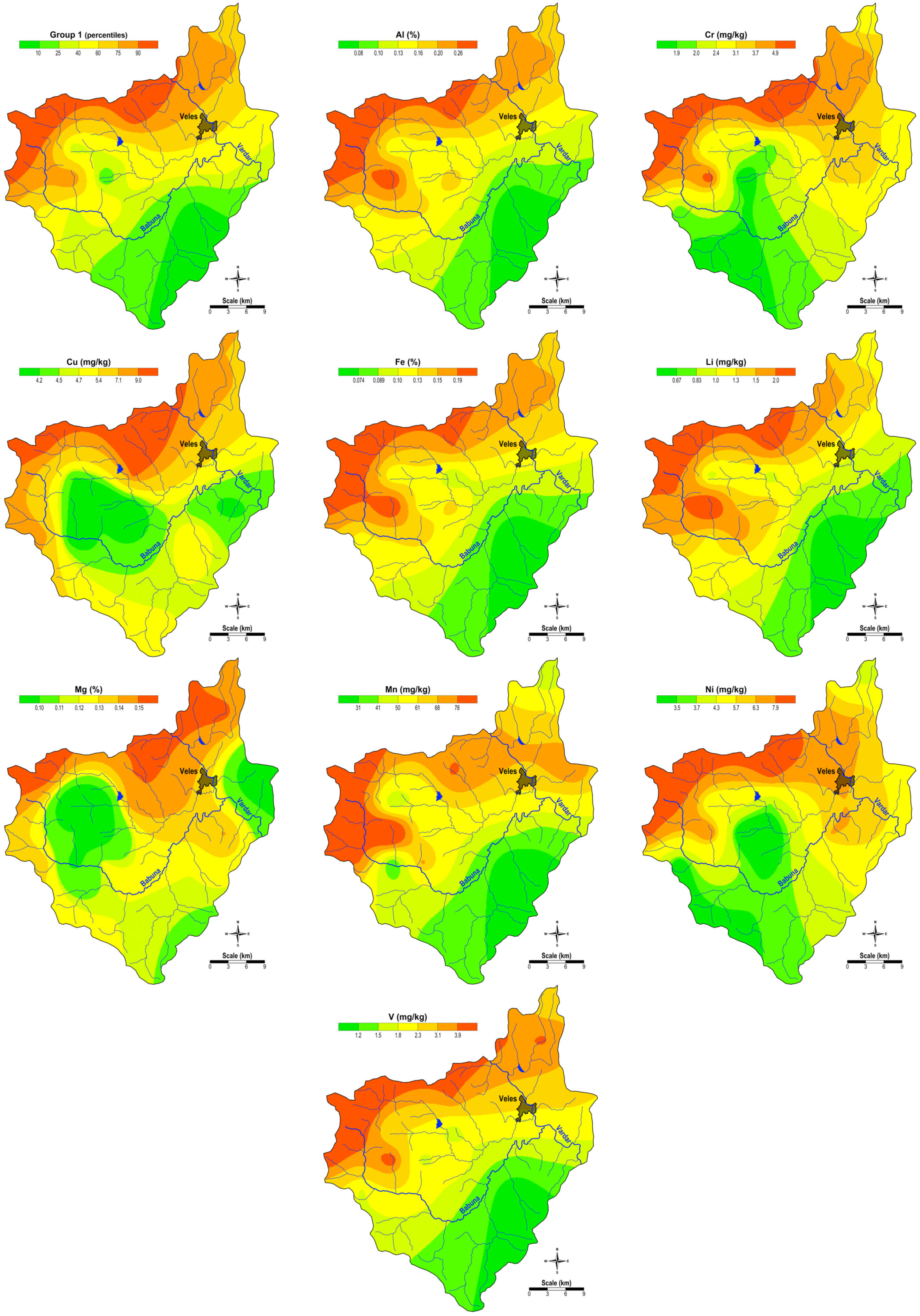
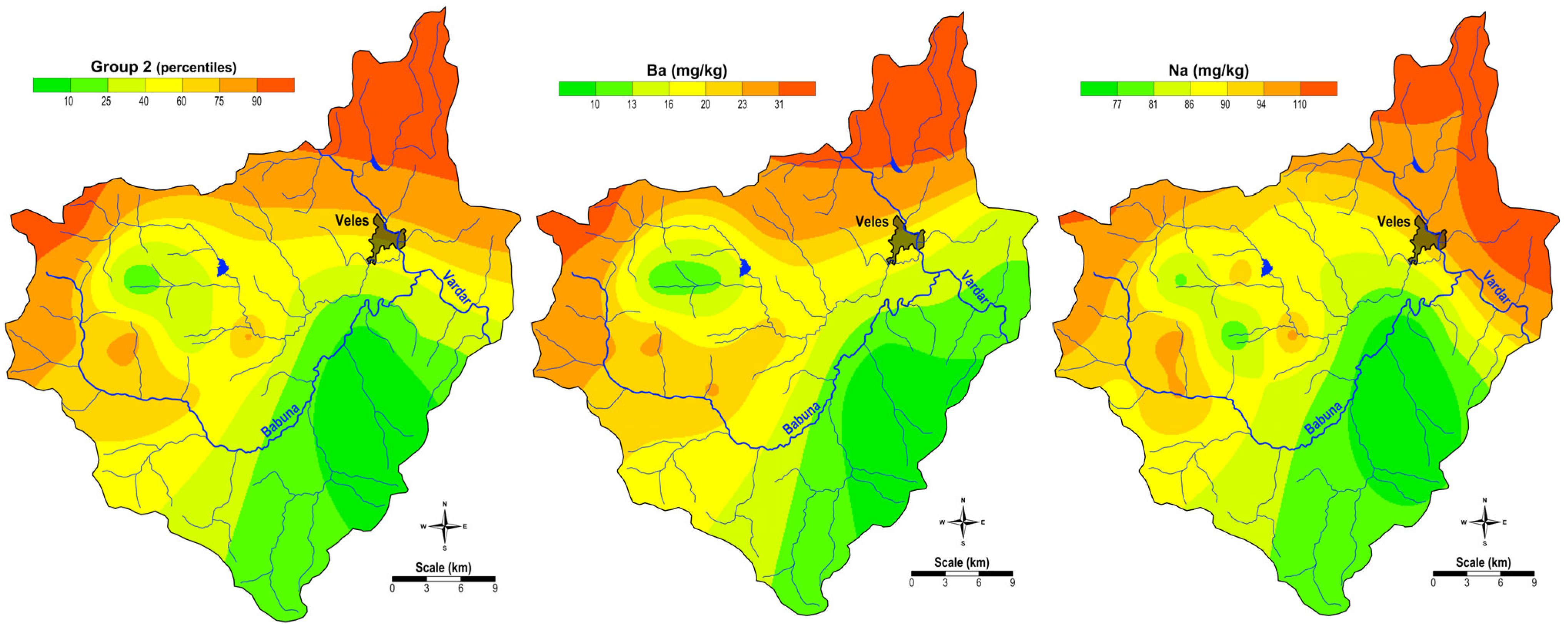

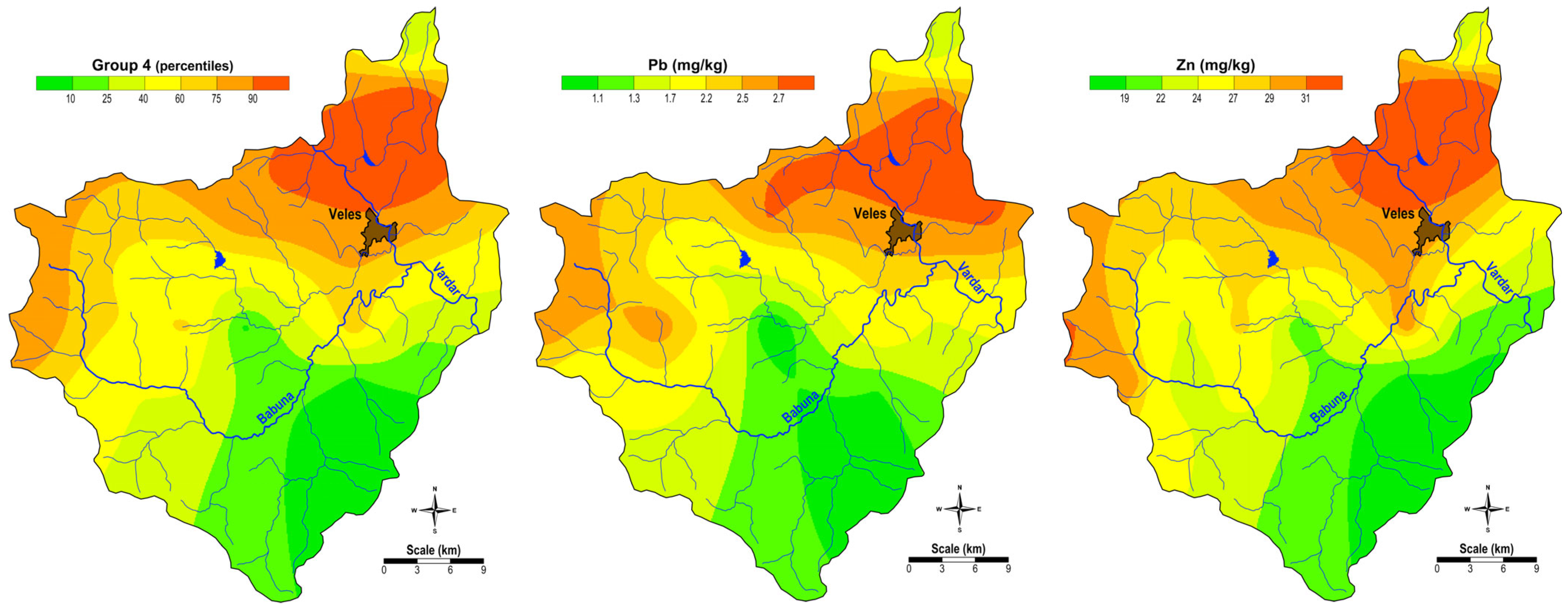
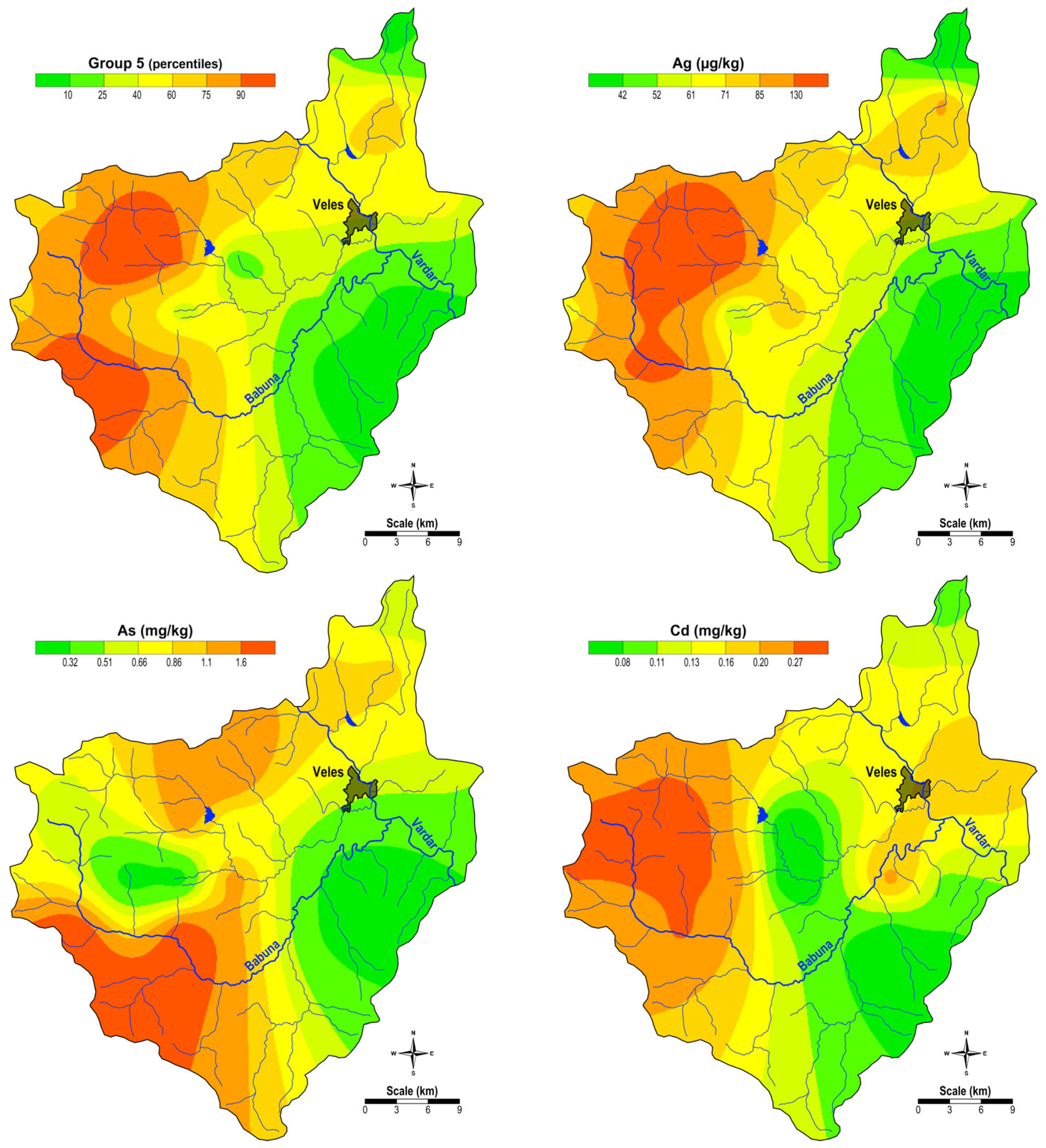


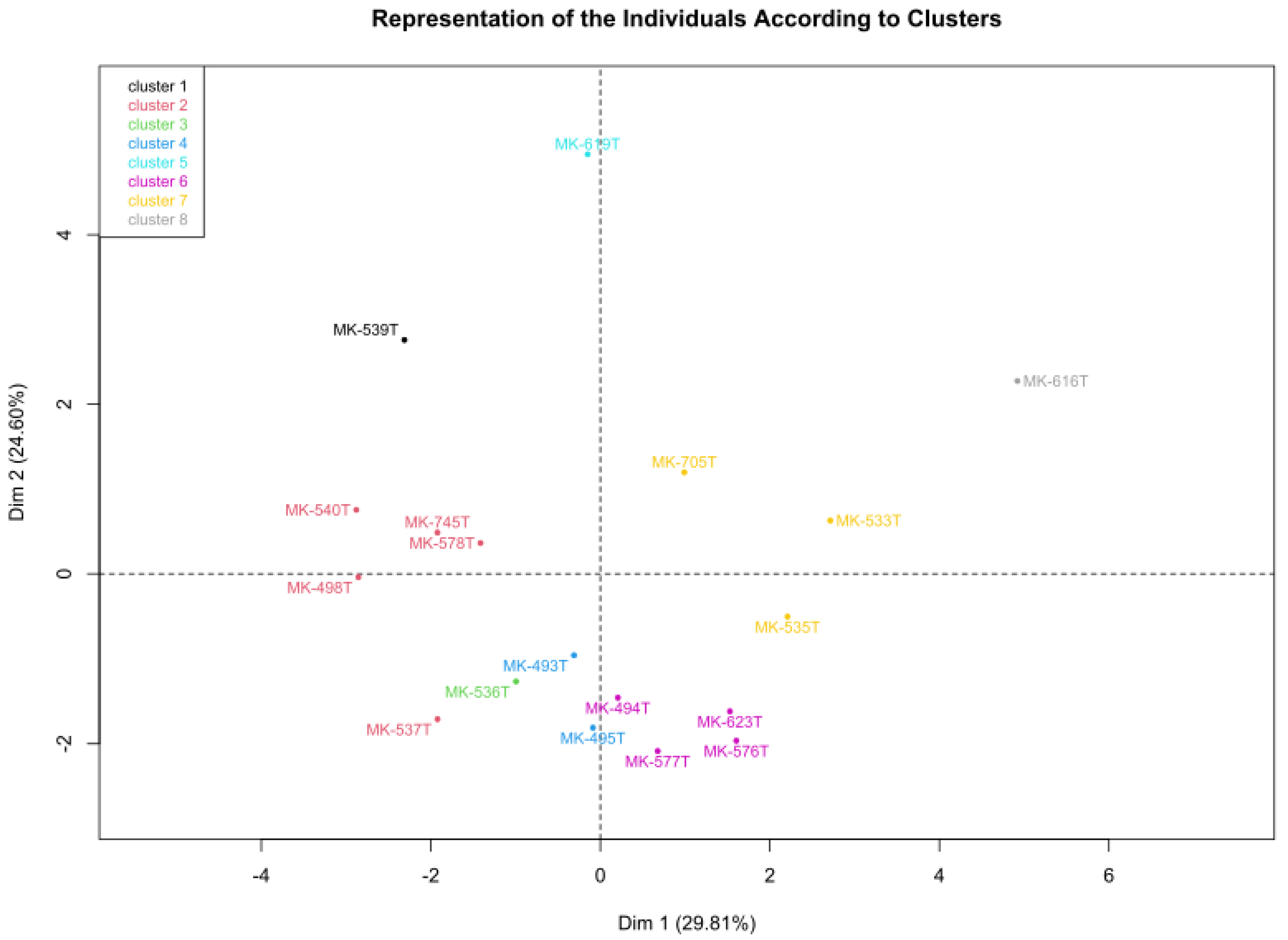

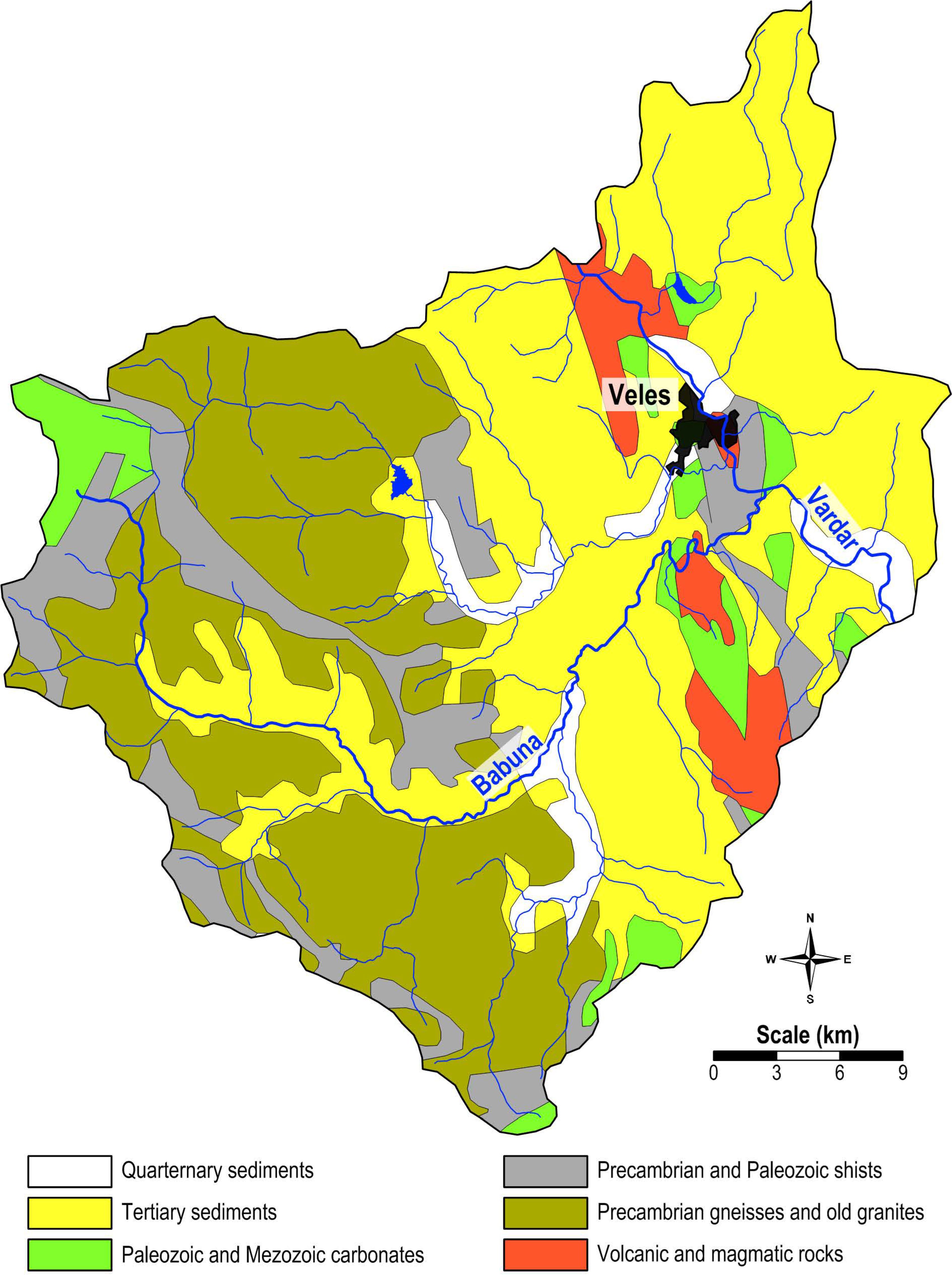
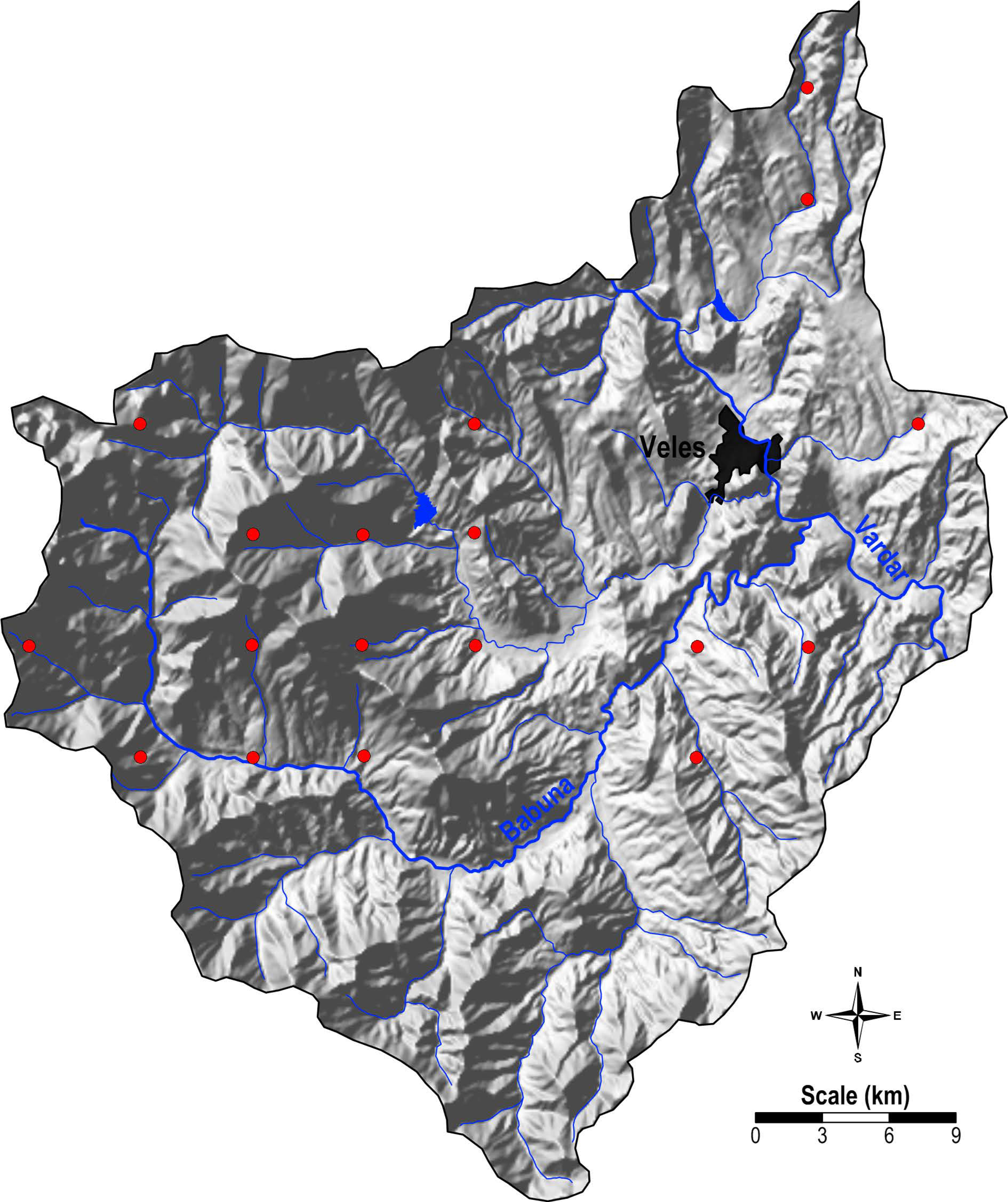
| Elements | Unit | X | Md | Min | Max | P10 | P90 | P25 | P75 | S | Sx | CV | A | E |
|---|---|---|---|---|---|---|---|---|---|---|---|---|---|---|
| Ag | µg/kg | 99 | 73 | 29 | 430 | 33 | 170 | 53 | 110 | 91 | 21.5 | 92.1 | 3.19 | 11.68 |
| Al | % | 0.19 | 0.16 | 0.069 | 0.49 | 0.088 | 0.37 | 0.13 | 0.23 | 0.11 | 0.025 | 56.4 | 1.56 | 2.32 |
| As | mg/kg | 0.88 | 0.66 | 0.25 | 2.5 | 0.25 | 2.2 | 0.25 | 1.3 | 0.67 | 0.16 | 76.6 | 1.35 | 1.39 |
| Ba | mg/kg | 22 | 21 | 7.7 | 48 | 11 | 41 | 12 | 25 | 11 | 2.6 | 49.7 | 0.99 | 0.69 |
| Ca | % | 0.49 | 0.48 | 0.31 | 0.64 | 0.38 | 0.62 | 0.44 | 0.54 | 0.087 | 0.021 | 17.9 | −0.05 | −0.19 |
| Cd | mg/kg | 0.18 | 0.20 | 0.047 | 0.35 | 0.05 | 0.28 | 0.10 | 0.25 | 0.089 | 0.021 | 48.3 | −0.06 | −0.84 |
| Cr | mg/kg | 3.7 | 2.7 | 1.7 | 12 | 1.9 | 7.1 | 2.2 | 4.2 | 2.6 | 0.60 | 69.3 | 2.12 | 4.76 |
| Cu | mg/kg | 6.2 | 4.9 | 3.2 | 13 | 3.7 | 11 | 4.0 | 7.9 | 2.9 | 0.68 | 46.8 | 1.17 | 0.57 |
| Fe | % | 0.15 | 0.12 | 0.062 | 0.34 | 0.080 | 0.28 | 0.11 | 0.17 | 0.07 | 0.02 | 48.9 | 1.51 | 1.99 |
| K | % | 0.28 | 0.26 | 0.14 | 0.49 | 0.19 | 0.35 | 0.24 | 0.31 | 0.07 | 0.02 | 26.2 | 1.14 | 3.53 |
| Li | mg/kg | 1.5 | 1.3 | 0.53 | 3.7 | 0.75 | 3.2 | 0.96 | 1.7 | 0.84 | 0.20 | 56.1 | 1.53 | 2.09 |
| Mg | % | 0.12 | 0.12 | 0.071 | 0.17 | 0.085 | 0.16 | 0.10 | 0.14 | 0.03 | 0.01 | 22.1 | −0.18 | −0.47 |
| Mn | mg/kg | 62 | 60 | 23 | 110 | 33 | 94 | 43 | 76 | 24 | 5.5 | 38.1 | 0.46 | −0.25 |
| Mo | µg/kg | 130 | 100 | 50 | 350 | 50 | 300 | 50 | 210 | 96 | 22.6 | 74.2 | 1.10 | 0.34 |
| Na | mg/kg | 99 | 90 | 71 | 230 | 73 | 130 | 85 | 96 | 35 | 8.2 | 35.0 | 3.20 | 11.50 |
| Ni | mg/kg | 5.7 | 4.8 | 3.1 | 13 | 3.2 | 9.5 | 3.7 | 6.4 | 2.6 | 0.62 | 45.8 | 1.51 | 2.35 |
| P | mg/kg | 570 | 550 | 310 | 900 | 350 | 830 | 490 | 670 | 150 | 36.4 | 27.0 | 0.35 | −0.06 |
| Pb | mg/kg | 2.1 | 2.1 | 0.93 | 3.3 | 1.2 | 2.9 | 1.7 | 2.6 | 0.65 | 0.15 | 30.8 | 0.10 | −0.62 |
| Sr | mg/kg | 16 | 16 | 8.3 | 25 | 8.4 | 22 | 12 | 19 | 4.7 | 1.10 | 29.8 | 0.13 | −0.69 |
| V | mg/kg | 2.8 | 2.2 | 1.1 | 7.2 | 1.4 | 4.7 | 1.7 | 3.9 | 1.6 | 0.37 | 56.5 | 1.61 | 2.71 |
| Zn | mg/kg | 27 | 27 | 18 | 39 | 20 | 32 | 23 | 30 | 5.1 | 1.19 | 19.0 | 0.38 | 0.60 |
| Element | Unit | X | Md | Min | Max | P10 | P90 | P25 | P75 | S | Sx | CV | A | E |
|---|---|---|---|---|---|---|---|---|---|---|---|---|---|---|
| Ag | mg/kg | 1.25 | 0.94 | 0.34 | 2.87 | 0.46 | 2.65 | 0.56 | 1.86 | 0.89 | 0.21 | 71.5 | 0.89 | −0.82 |
| Al | % | 19.3 | 18.6 | 7.87 | 42.5 | 9.20 | 31.2 | 11.4 | 24.0 | 9.77 | 2.30 | 50.4 | 0.82 | 0.17 |
| Ba | mg/kg | 690 | 363 | 147 | 3475 | 226 | 1618 | 246 | 481 | 946 | 223 | 137 | 2.55 | 5.58 |
| Ca | % | 22.1 | 9.09 | 3.37 | 112 | 4.46 | 64.2 | 5.42 | 16.3 | 30.0 | 7.07 | 135 | 2.17 | 4.26 |
| Cd | mg/kg | 2.25 | 2.25 | 2.03 | 2.48 | 2.07 | 2.44 | 2.13 | 2.37 | 0.20 | 0.10 | 8.7 | 0.11 | −1.76 |
| Cr | mg/kg | 105 | 86.3 | 36.6 | 353 | 45.7 | 162 | 56.3 | 124 | 76.7 | 18.0 | 72.8 | 2.28 | 6.18 |
| Cu | mg/kg | 12.2 | 12.1 | 3.20 | 21.8 | 4.30 | 19.6 | 8.45 | 18.1 | 5.89 | 1.39 | 48.1 | 0.05 | −1.19 |
| Fe | % | 20.5 | 18.2 | 9.54 | 34.5 | 12.3 | 31.0 | 15.1 | 26.6 | 7.44 | 1.75 | 36.3 | 0.48 | −0.95 |
| K | % | 15.0 | 15.0 | 8.58 | 23.4 | 10.0 | 20.4 | 12.8 | 17.2 | 4.04 | 0.95 | 26.8 | 0.26 | −0.13 |
| Li | mg/kg | 13.4 | 14.2 | 6.23 | 25.3 | 8.09 | 18.4 | 9.21 | 15.9 | 4.84 | 1.14 | 35.9 | 0.65 | 0.57 |
| Mg | % | 4.58 | 4.14 | 1.51 | 9.44 | 2.21 | 8.09 | 2.53 | 6.42 | 2.49 | 0.59 | 54.4 | 0.69 | −0.63 |
| Mn | mg/kg | 489 | 451 | 200 | 1455 | 221 | 706 | 276 | 560 | 298 | 70.2 | 61.0 | 2.12 | 6.07 |
| Mo | mg/kg | 8.54 | 6.44 | 5.99 | 13.2 | 5.99 | 12.3 | 6.00 | 11.0 | 3.38 | 1.51 | 39.6 | 0.83 | −1.96 |
| Na | % | 12.5 | 13.3 | 3.12 | 26.4 | 3.87 | 17.5 | 8.59 | 16.2 | 5.98 | 1.41 | 47.7 | 0.23 | 0.40 |
| Ni | mg/kg | 54.9 | 23.6 | 6.81 | 233 | 10.0 | 133 | 17.4 | 75.9 | 62.4 | 14.7 | 113 | 1.76 | 2.82 |
| P | mg/kg | 262 | 264 | 106 | 476 | 116 | 381 | 189 | 302 | 102 | 24.1 | 39.2 | 0.30 | 0.05 |
| Pb | mg/kg | 26.4 | 25.6 | 16.3 | 51.7 | 17.2 | 33.3 | 19.9 | 29.9 | 8.76 | 2.07 | 33.1 | 1.49 | 3.09 |
| Sr | mg/kg | 67.6 | 62.2 | 25.1 | 151 | 33.5 | 103 | 43.5 | 76.0 | 35.2 | 8.31 | 52.2 | 1.43 | 2.05 |
| V | mg/kg | 49.5 | 44.5 | 23.7 | 90.3 | 28.7 | 70.8 | 37.8 | 63.8 | 19.3 | 4.55 | 38.9 | 0.74 | −0.16 |
| Zn | mg/kg | 86.0 | 82.2 | 61.9 | 128 | 64.9 | 107 | 68.6 | 99 | 19.4 | 4.58 | 22.6 | 0.63 | −0.40 |
| Element | Veles Region (Present Work); n = 18 | North Macedonia, 2015 [27]; n = 72 | ||
|---|---|---|---|---|
| Median | Range | Median | Range | |
| Ag | 0.099 | 0.029–0.43 | - | - |
| Al | 1900 | 690–4900 | 2100 | 750–7400 |
| As | 0.88 | 0.25–2.5 | 0.48 | 0.13–1.4 |
| Ba | 22 | 7.7–48 | 42 | 9.7–180 |
| Ca | 4900 | 3100–6400 | 6900 | 3500–13,000 |
| Cd | 0.18 | 0.047–0.35 | 0.23 | 0.018–0.88 |
| Cr | 3.7 | 1.7–12 | 5.7 | 1.8–31 |
| Cu | 6.2 | 3.2–4.9 | 4.6 | 3.0–8.3 |
| Fe | 1500 | 620–3400 | 1700 | 510–4600 |
| K | 2800 | 1400–4900 | 6000 | 3100–14,000 |
| Li | 1.5 | 0.53–3.7 | 0.79 | 0.32–3.5 |
| Mg | 1200 | 710–1700 | 1900 | 1200–1200 |
| Mn | 62 | 23–110 | 160 | 33–510 |
| Na | 99 | 71–230 | 190 | 140–380 |
| Ni | 5.7 | 3.1–13 | 3.5 | 0.68–63 |
| P | 570 | 310–900 | 1100 | 420–2000 |
| Pb | 2.1 | 0.93–3.3 | 4.9 | 2.2–14 |
| Sr | 16 | 8.3–2.2 | 25 | 6.5–220 |
| V | 2.8 | 1.1–7.2 | 3.3 | 0.47–11 |
| Zn | 27 | 18–39 | 30 | 12–66 |
| Element | Ag | Al | As | Ba | Ca | Cd | Cr | Cu | Fe | K | Li | Mg | Mn | Mo | Na | Ni | P | Pb | Sr | V | Zn |
|---|---|---|---|---|---|---|---|---|---|---|---|---|---|---|---|---|---|---|---|---|---|
| Ag | 1.00 | ||||||||||||||||||||
| Al | 0.36 | 1.00 | |||||||||||||||||||
| As | 0.45 | 0.36 | 1.00 | ||||||||||||||||||
| Ba | −0.01 | 0.79 | 0.38 | 1.00 | |||||||||||||||||
| Ca | −0.05 | 0.28 | −0.13 | 0.37 | 1.00 | ||||||||||||||||
| Cd | 0.60 | 0.34 | 0.00 | 0.02 | 0.03 | 1.00 | |||||||||||||||
| Cr | −0.02 | 0.59 | −0.18 | 0.36 | 0.35 | 0.16 | 1.00 | ||||||||||||||
| Cu | −0.02 | 0.38 | 0.39 | 0.45 | 0.04 | −0.23 | 0.45 | 1.00 | |||||||||||||
| Fe | 0.34 | 0.99 | 0.33 | 0.78 | 0.26 | 0.39 | 0.61 | 0.34 | 1.00 | ||||||||||||
| K | −0.41 | 0.09 | 0.10 | 0.35 | 0.29 | −0.67 | 0.08 | 0.47 | 0.04 | 1.00 | |||||||||||
| Li | 0.38 | 0.95 | 0.38 | 0.73 | 0.26 | 0.37 | 0.45 | 0.28 | 0.95 | 0.07 | 1.00 | ||||||||||
| Mg | −0.35 | 0.34 | 0.13 | 0.56 | 0.43 | −0.43 | 0.45 | 0.72 | 0.30 | 0.66 | 0.32 | 1.00 | |||||||||
| Mn | 0.25 | 0.79 | 0.28 | 0.55 | 0.07 | 0.31 | 0.46 | 0.39 | 0.80 | 0.25 | 0.83 | 0.26 | 1.00 | ||||||||
| Mo | −0.14 | −0.02 | −0.31 | −0.19 | 0.23 | −0.20 | 0.19 | −0.11 | −0.05 | 0.38 | −0.10 | −0.02 | 0.11 | 1.00 | |||||||
| Na | −0.05 | 0.59 | 0.34 | 0.69 | 0.07 | −0.04 | 0.29 | 0.31 | 0.59 | 0.11 | 0.41 | 0.16 | 0.41 | −0.10 | 1.00 | ||||||
| Ni | 0.06 | 0.48 | −0.21 | 0.19 | 0.29 | 0.28 | 0.95 | 0.41 | 0.50 | −0.03 | 0.35 | 0.36 | 0.38 | 0.18 | 0.13 | 1.00 | |||||
| P | −0.31 | 0.20 | 0.17 | 0.49 | 0.21 | −0.56 | 0.20 | 0.65 | 0.16 | 0.89 | 0.11 | 0.67 | 0.35 | 0.21 | 0.35 | 0.06 | 1.00 | ||||
| Pb | 0.26 | 0.60 | −0.05 | 0.41 | 0.14 | 0.54 | 0.68 | 0.37 | 0.64 | −0.09 | 0.54 | 0.23 | 0.61 | −0.02 | 0.28 | 0.74 | 0.05 | 1.00 | |||
| Sr | 0.11 | 0.42 | 0.25 | 0.48 | 0.64 | −0.12 | −0.05 | 0.08 | 0.36 | 0.52 | 0.46 | 0.41 | 0.29 | 0.35 | 0.17 | −0.12 | 0.36 | −0.03 | 1.00 | ||
| V | 0.34 | 0.95 | 0.27 | 0.75 | 0.22 | 0.38 | 0.71 | 0.41 | 0.96 | 0.01 | 0.84 | 0.29 | 0.73 | −0.06 | 0.65 | 0.62 | 0.19 | 0.72 | 0.22 | 1.00 | |
| Zn | 0.29 | 0.44 | 0.32 | 0.51 | 0.13 | 0.32 | 0.29 | 0.51 | 0.46 | 0.24 | 0.46 | 0.37 | 0.53 | −0.35 | 0.17 | 0.32 | 0.38 | 0.67 | 0.09 | 0.50 | 1.00 |
| Soil | Moss | t | df | p |
|---|---|---|---|---|
| Ag_soil | Ag_moss | 5.35 | 17.00 | <0.001 |
| Al_soil | Al_moss | 7.30 | 17.00 | <0.001 |
| As_soil | As_moss | 49.75 | 12.00 | <0.001 |
| Ba_soil | Ba_moss | 3.00 | 17.00 | 0.008 |
| Ca_soil | Ca_moss | 2.44 | 17.00 | 0.026 |
| Cd_soil | Cd_moss | 18.04 | 3.00 | <0.001 |
| Co_soil | Co_moss | NaN a | ||
| Cr_soil | Cr_moss | 5.62 | 17.00 | <0.001 |
| Cu_soil | Cu_moss | 4.14 | 17.00 | <0.001 |
| Fe_soil | Fe_moss | 10.41 | 17.00 | <0.001 |
| K_soil | K_moss | 13.30 | 17.00 | <0.001 |
| Li_soil | Li_moss | 9.94 | 17.00 | <0.001 |
| Mg_soil | Mg_moss | 5.94 | 17.00 | <0.001 |
| Mn_soil | Mn_moss | 5.90 | 17.00 | <0.001 |
| Mo_soil | Mo_moss | 3.49 | 2.00 | 0.073 |
| Na_soil | Na_moss | 8.82 | 17.00 | <0.001 |
| Ni_soil | Ni_moss | 3.36 | 17.00 | 0.004 |
| P_soil | P_moss | −15.61 | 17.00 | <0.001 |
| Pb_soil | Pb_moss | 11.59 | 17.00 | <0.001 |
| Sr_soil | Sr_moss | 5.99 | 17.00 | <0.001 |
| V_soil | V_moss | 10.06 | 17.00 | <0.001 |
| Zn_soil | Zn_moss | 11.96 | 17.00 | <0.001 |
Disclaimer/Publisher’s Note: The statements, opinions and data contained in all publications are solely those of the individual author(s) and contributor(s) and not of MDPI and/or the editor(s). MDPI and/or the editor(s) disclaim responsibility for any injury to people or property resulting from any ideas, methods, instructions or products referred to in the content. |
© 2025 by the authors. Licensee MDPI, Basel, Switzerland. This article is an open access article distributed under the terms and conditions of the Creative Commons Attribution (CC BY) license (https://creativecommons.org/licenses/by/4.0/).
Share and Cite
Stafilov, T.; Bačeva Andonovska, K.; Šajn, R.; Jeftimova, M. Assessing the Distribution of Potentially Toxic Elements in Bryophytes in Relation to Surface Soil Contamination in the Veles Region, North Macedonia. Plants 2025, 14, 783. https://doi.org/10.3390/plants14050783
Stafilov T, Bačeva Andonovska K, Šajn R, Jeftimova M. Assessing the Distribution of Potentially Toxic Elements in Bryophytes in Relation to Surface Soil Contamination in the Veles Region, North Macedonia. Plants. 2025; 14(5):783. https://doi.org/10.3390/plants14050783
Chicago/Turabian StyleStafilov, Trajče, Katerina Bačeva Andonovska, Robert Šajn, and Marija Jeftimova. 2025. "Assessing the Distribution of Potentially Toxic Elements in Bryophytes in Relation to Surface Soil Contamination in the Veles Region, North Macedonia" Plants 14, no. 5: 783. https://doi.org/10.3390/plants14050783
APA StyleStafilov, T., Bačeva Andonovska, K., Šajn, R., & Jeftimova, M. (2025). Assessing the Distribution of Potentially Toxic Elements in Bryophytes in Relation to Surface Soil Contamination in the Veles Region, North Macedonia. Plants, 14(5), 783. https://doi.org/10.3390/plants14050783








